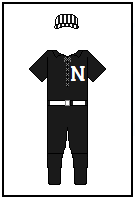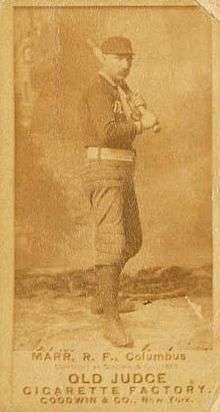Nashville Seraphs
|
Nashville Seraphs 1895 Nashville, Tennessee | |||
| |||
| Class-level | |||
|---|---|---|---|
| Previous | Class B | ||
| Minor league affiliations | |||
Previous leagues | Southern League | ||
| Major league affiliations | |||
| Previous | Unaffiliated | ||
| Minor league titles | |||
| Pennants (1) | 1895 | ||
| Team data | |||
| Nickname | Nashville Seraphs | ||
| Ballpark | Athletic Park | ||


The Nashville Seraphs were a minor league baseball team that played in the Class B Southern League in 1895. They were located in Nashville, Tennessee, and played their home games at Athletic Park. The Seraphs won the Southern League pennant in their only year of existence, making them the first Nashville minor league baseball team to win a league championship.
Team history
Nashville's previous Southern League club, the Nashville Tigers, ceased to play when the league suspended operations approximately nine games into the second half of the 1894 season. On January 14, 1895, Southern League officials granted an expansion franchise in the city to W. H. Stallings.[1] Nashville's new team for the 1895 season was called the Seraphs. The Nashville club joined eight other teams in the circuit: the Atlanta Crackers, Chattanooga Warriors (subsequently the Mobile Bluebirds), Evansville Blackbirds, Little Rock Travelers, Memphis Giants (also known as the Memphis Lambs), Montgomery Grays, and New Orleans Pelicans.[2] The Seraphs played their home games at Athletic Park, which would later come to be known as Sulphur Dell.
The Seraphs were managed by player-manager George Stallings, who was the team's backup catcher.[3] Stallings previously managed the Nashville Tigers, and would later manage the Boston Braves to win the 1914 World Series.[3] Daniel Sweeney also managed the team at some point in the season.[4]
The team participated in a number of exhibition games against major league teams, local athletic clubs, and the Vanderbilt Commodores before the season began.[5] One such series consisted of three games against the National League's Cleveland Spiders. Nashville won one of the games, 4–3, in which Seraphs ace pitcher Sam Moran out dueled Cleveland's 28-year-old ace, Cy Young.[6]
Nashville's first game of the season was a 17–20 loss played in Evansville, Indiana, against the Evansville Black Birds.[5] The Seraphs defeated the New Orleans Pelicans in both games of a July 4 doubleheader, 12–0 and 9–4.[7] On July 27, Frank Butler, a Seraphs outfielder, had his contract purchased by the National League's New York Giants for US$1,000.[8] Butler achieved a .371 batting average and 34 stolen bases during his time in Nashville.[1]
By mid-August, Nashville was in third-place behind Evansville and the Atlanta Crackers. The race for the Southern League championship, determined by winning percentage, heated up following a disputed call during an August 10 contest at Athletic Park versus Atlanta. Nashville was trailing 10–8 in their last at bat in the ninth inning. They scored a run and still had men on first and second base with their catcher, Daniel Sweeney, at the plate. He hit a high foul fly ball back toward the grandstand. As Atlanta's catcher, Tug Wilson, attempted to get under the ball, his foot slipped causing him to miss it. While reaching for the ball, a boy in the stands threw a baseball glove or cap past his head. The umpire, Clark, ruled this as interference and called Sweeney out, resulting in a 10–9 Seraphs loss. This incident would come to be known as the "Glove Game."[5]
Following the defeat, Nashville went on a 20-game winning streak, moving them into first-place with only a few games left to play.[5] The last day of scheduled play was September 2, but Atlanta, who held second place, played an additional game on September 3 to make up a rain-postponed game.[5] This additional win by Atlanta, as well as the removal of several games deemed illegal by league president J.B. Nicklin, made it appeared that Atlanta and Nashville were tied for first-place with the same .699 winning percentage.[9] A closer look, however, revealed that Atlanta was actually ahead with a .66999 record to Nashville's .66998.[9]
Nashville claimed to be the rightful pennant winners and protested the final standings for three reasons.[9] Firstly, the August 10 "Glove Game" should have been thrown out because of the umpire's bad call. Secondly, New Orleans used an ineligible player who had been suspended from the Pennsylvania State League, and should forfeit all games in which he participated. Lastly, since Atlanta played a game one day after the official end of the season, their September 3 win should be stricken from their record.[5]
Southern League and team representatives held a meeting on September 7–8 in Chattanooga to determine a winner.[10] After two days of discussions,[11] their decision was to throw out the "Glove Game" on the basis that the umpire's ruling was illegal since there was no rule providing for the punishment of a club for the interference of an outsider. Atlanta's September 3 game was also declared null since it was played after the season was over.[9] Nashville withdrew its protest of New Orleans’ ineligible player.[5] These rulings caused the Seraphs' winning percentage to rise to .670 and Atlanta's to fall to .667, making Nashville the league pennant winner.[9][10] (Some sources cite the final adjusted record as Seraphs: .676 (71–34); and Atlanta: .667 (68–34).[5]) Atlanta challenged the decision at the league's annual meeting on December 21 in Birmingham, but Nashville's pennant-winning season was upheld.[9][12] This was this first league championship to be won by a team hailing from Nashville.[13]
On August 18, during the heat of the pennant race and only eight days after pitching in the "Glove Game", the contract of ace pitcher Sam Moran was purchased by the National League's Pittsburg Pirates[5][14] At the time of his departure, Moran's record was 22–12; he had also recorded 113 strike outs with Nashville.[15]
Despite the championship season, financial instability kept the Seraphs from returning to play in 1896. The city of Nashville was left without a professional baseball team until the Nashville Centennials franchise was formed as a member of the Central League in 1897.[16]
Season results
These records show the results as they stood at the end of the season and do not reflect the removal of several games deemed illegal by Southern League President J.B. Nicklin.[9]
| Year | Wins | Losses | Win % | GB | Finish |
|---|---|---|---|---|---|
| 1895[17] | 69 | 38 | .645 | 1 | 2nd |
Record vs. opponents
| 1895 Nashville record vs. opponents[9] | |
|---|---|
| Team | Nashville |
| Atlanta | 8–11 |
| Evansville | 10–9 |
| Little Rock | 8–1 |
| Mobile | 10–5 |
| Montgomery | 16–3 |
| Memphis | 6–2 |
| New Orleans | 11–7 |
| Totals | 69–38 |
Roster
.jpg)

Of the nineteen men who played for the Seraphs, nine also played for major league teams during their careers.[18]
| Name | Position(s) | Major league experience |
|---|---|---|
| Butler, FrankFrank Butler | Outfielder[1] | New York Giants (1895) |
| George Cleve | — | — |
| Edward Daniels | — | — |
| Al Gibson | — | — |
| Richard Gorman | — | — |
| Herman, ArtArt Herman | — | Louisville Colonels (1896–97) |
| Julius Knoll | — | — |
| Patrick Lynch | — | — |
| Marr, LeftyLefty Marr | — | Cincinnati Red Stockings (1886) Columbus Solons (1889) Cincinnati Reds (1890–91) Cincinnati Kelly's Killers (1891) |
| Jack McCann | — | — |
| McCreery, TomTom McCreery | — | Louisville Colonels (1895–97) New York Giants (1897–98) Pittsburg Pirates (1898–1900) Brooklyn Superbas (1901–03) Boston Beaneaters (1903) |
| Ed McZena | — | — |
| Moran, SamSam Moran | Pitcher[6] | Pittsburg Pirates (1895) |
| Myers, BertBert Myers | — | St. Louis Browns (1896) Washington Senators (1898) Philadelphia Phillies (1900) |
| Ritz, JimJim Ritz | — | Pittsburg Pirates (1894) |
| Henry Smith | — | — |
| Stallings, GeorgeGeorge Stallings | Manager/Catcher[3] | Brooklyn Bridegrooms (1890) Philadelphia Phillies (1897–98) |
| Daniel Sweeney | Catcher[5] | — |
| Trost, MikeMike Trost | — | St. Louis Browns (1890) Louisville Colonels (1895) |
References
- General
- "Victor Baseball Guide". Overman Wheel Co. 1896. Retrieved February 2, 2015.
- Specific
- 1 2 3 "Nashville Baseball Timeline". Sulphur Dell. Retrieved October 7, 2008.
- ↑ "1895 Southern Association Statistics". Baseball-Reference.com. Retrieved January 28, 2015.
- 1 2 3 Nipper, Skip (January 18, 2015). "T'was Walks That Killed The "Miracle Man"". 262 Down Right. Retrieved January 28, 2015.
- ↑ Victor Baseball Guide, p. 196
- 1 2 3 4 5 6 7 8 9 10 Traughber, Bill (May 16, 2011). "Looking Back: The 1895 Nashville Seraphs". Nashville Sounds. Minor League Baseball. Retrieved January 28, 2015.
- 1 2 Traughber, Bill (August 15, 2011). "Looking Back: Cy Young Pitches in Nashville". Nashville Sounds. Minor League Baseball. Retrieved January 29, 2015.
- ↑ "Southern League". The Morning Times. Washington, D.C. July 5, 1895. p. 6. Retrieved February 17, 2015.
- ↑ "Frank Butler Statistics and History". Baseball-Reference.com. Retrieved January 28, 2015.
- 1 2 3 4 5 6 7 8 Victor Baseball Guide, pp. 259–260
- 1 2 "Nashville Gets the Pennant". The Morning Times. Washington, D.C. September 9, 1895. p. 1. Retrieved February 17, 2015.
- ↑ "Base Ball Notes". Evening Star. Washington, D.C. September 10, 1895. p. 10. Retrieved February 17, 2015.
- ↑ "Pennant Squabble Settled". The Austin Weekly Statesman. Austin, Texas. December 26, 1895. p. 3. Retrieved February 17, 2015.
- ↑ Traughber, Bill (July 18, 2011). "Looking Back: Nashville's Baseball Championships". Nashville Sounds. Minor League Baseball. Retrieved January 28, 2015.
- ↑ "Sam Moran Statistics and History". Baseball-Reference.com. Retrieved January 28, 2015.
- 1 2 Victor Baseball Guide, p. 260
- ↑ Nipper, Skip (January 18, 2015). "Nashville in the 1897 Central League". 262 Down Right. Retrieved January 28, 2015.
- ↑ "Timeline" (PDF). Southern Association Baseball. Retrieved September 15, 2015.
- ↑ "1895 Nashville Seraphs Statistics". Baseball-Reference.com. Retrieved January 28, 2015.
